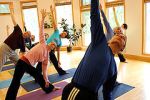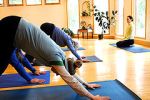Yoga
 As young children, we all moved with unselfconscious grace, but from hunching over a school desk to slumping in front of a computer or television, many of us spend much of our lives with rounded shoulders and crumpled spines, and the heavy bags we carry often twist us to one side, too. Most forms of exercise will help us look and feel better, but poor posture can sabotage a fitness regime, making the exercise harder and leaving well-toned muscles further out of alignment than before. There is no such danger with yoga, and it is excellent for strengthening muscles and improving flexibility. In addition, its emphasis on lengthening and straightening the spine makes for perfect posture, creating an appearance of height and slenderness. Its regulated pattern of breathing lowers stress levels and eases tension from our faces as well as our bodies.
As young children, we all moved with unselfconscious grace, but from hunching over a school desk to slumping in front of a computer or television, many of us spend much of our lives with rounded shoulders and crumpled spines, and the heavy bags we carry often twist us to one side, too. Most forms of exercise will help us look and feel better, but poor posture can sabotage a fitness regime, making the exercise harder and leaving well-toned muscles further out of alignment than before. There is no such danger with yoga, and it is excellent for strengthening muscles and improving flexibility. In addition, its emphasis on lengthening and straightening the spine makes for perfect posture, creating an appearance of height and slenderness. Its regulated pattern of breathing lowers stress levels and eases tension from our faces as well as our bodies.
Yoga has become very popular in the past few decades that we don’t always remember where it came from. We usually regard it as a set of flexibility exercises or add it to a standard fitness regime as a stretch component. True, it is one of the best ways to build suppleness and delay the onset of old age. But yoga is far more than that, and in India it has always been closely linked with Ayurvedic medicine. Its name is Sanskrit for Union or Connection: linking the body, mind and the other non-physical levels to the universal mind. It has several elements, but the exercises generally practised outside India are what’s called Hatha, or physical, yoga. Awareness of breathing is a central part of Hatha yoga and breath is synchronized with movement. Despite the effort you’re putting in, this leads toi a very calming, almost meditative rhythm that helps you push on through difficult parts. Pranayama – breathing exercises – form part of a standard yoga practice.
Hatha Yoga:  Hatha yoga was originally practised as an aid to meditation through controlling the body. Some movements, such as headstands, straight-legged body bends and backwards head rolls, can be dangerous for beginners. Others, such as stretches and twists, should not be forced. It’s safest to learn from a qualified yoga teacher who has trained with one of the major organizations. If you have health problems, don’t take up any form of exercise before checking both with your own doctor and with an exercise expert who knows about medical contradictions. Yoga can bring great benefits to people with heart disease, back problems or arthritis, but they should take it up under the guidance of an instructor trained to work with these conditions.
Hatha yoga was originally practised as an aid to meditation through controlling the body. Some movements, such as headstands, straight-legged body bends and backwards head rolls, can be dangerous for beginners. Others, such as stretches and twists, should not be forced. It’s safest to learn from a qualified yoga teacher who has trained with one of the major organizations. If you have health problems, don’t take up any form of exercise before checking both with your own doctor and with an exercise expert who knows about medical contradictions. Yoga can bring great benefits to people with heart disease, back problems or arthritis, but they should take it up under the guidance of an instructor trained to work with these conditions.